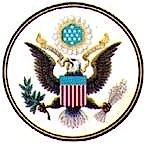Flag History
The Stars and Stripes
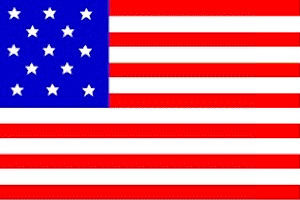 The Declaration of Independence severed all ties between the 13 American Colonies and Great Britain. For almost a full year after that first Independence Day, the flag of the new nation still bore the Union Jack among its red and white stripes. All of that changed on June 14, 1777, when the Marine Committee of the Second Continental Congress passed a resolution establishing a new design. The name of the "United Colonies" having been changed in September of the previous year, the resolution read:
The Declaration of Independence severed all ties between the 13 American Colonies and Great Britain. For almost a full year after that first Independence Day, the flag of the new nation still bore the Union Jack among its red and white stripes. All of that changed on June 14, 1777, when the Marine Committee of the Second Continental Congress passed a resolution establishing a new design. The name of the "United Colonies" having been changed in September of the previous year, the resolution read:
"Resolved, that the flag of the United States be thirteen stripes, alternate red and white; that the union be thirteen stars, white in a blue field representing a new constellation."
The Symbolism of Color
Ironically, the symbolism of the three colors found in the United States flag is set forth, not in the various resolutions authorizing the flag, but in a report Secretary of the Congress Charles Thompson wrote to define the Seal of our Nation. In that report he stated:
"The colors of the pales (the vertical stripes on the shield of the eagle) are those used in the flag of the United States of America; White signifies purity and innocence, Red, hardiness & valor, and Blue, the color of the Chief*, signifies vigilance, perseverance & Justice." (*The Chief is the blue band at the top of the shield.)
The leaders of the American revolution felt that their actions were somehow predestined by some higher power, that they not only had the right to declare independence from England but a destiny to do so. This thinking led them to represent the 13 colonies by inserting stars in the field of blue, one star for each of the colonies. They considered the union of these 13 individual "states" somewhat like a constellation in the heavens...several different stars arranged together to create a picture in the universe. The picture the stars created in the field of blue was strictly symbolic, however. The Congressional resolution establishing a flag of 13 red and white stripes and 13 stars in a field of blue did not establish how the stars should be arranged, or even how many points each star would have. For this reason the earliest United States flags had a variety of designs. On some, the "new constellation" was represented by 6-pointed stars, others by 5-pointed stars.
Most historians believe that Francis Hopkinson of New Jersey was largely responsible for not only the earlier Grand Union Flag, but that he was also responsible for the stars in the new flag. At the time the resolution was approved for the new flag, Mr. Hopkinson was Chairman of the Continental Navy Board's Middle Department. (Mr. Hopkinson was also instrumental in the design for the seal of our Nation.) The first Navy Stars and Stripes flag displayed the 13 stars in alternating rows of three and two. That is the flag you see at the top of this page.
The Betsy Ross Flag
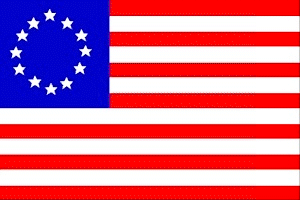 Of course, most of us remember the story of Betsy Ross and quickly recognize the "Betsy Ross Flag" with the stars in a circle. Betsy Ross made flags for the United States for 50 years. During the American Revolution she made flags for the Pennsylvania State Navy as well as other military units. The "Betsy Ross Flag" as seen here, however, did not appear until the early 1790's, and there is no solid evidence to support claims that Betsy Ross created the first stars and stripes.
Of course, most of us remember the story of Betsy Ross and quickly recognize the "Betsy Ross Flag" with the stars in a circle. Betsy Ross made flags for the United States for 50 years. During the American Revolution she made flags for the Pennsylvania State Navy as well as other military units. The "Betsy Ross Flag" as seen here, however, did not appear until the early 1790's, and there is no solid evidence to support claims that Betsy Ross created the first stars and stripes.
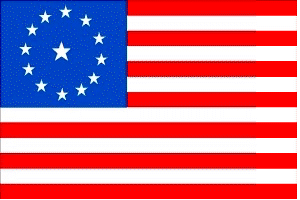 Thus it was that the earliest Colonial armies served under a variety of differently designed flags. On some the stars were displayed in rows of 4-5-4, on others the stars seemed to be scattered in the field of blue without any sense of order. The Third Maryland Regiment was reported to have first used a flag similar to the one here as early as 1777. We do know that such a flag, with a circle of 12 stars and one star in the center, was present as early as January 17, 1781 at the Battle of Cowpens, South Carolina. The original flag from that battle, with the stars arranged as seen here, now hangs in the Maryland State House.
Thus it was that the earliest Colonial armies served under a variety of differently designed flags. On some the stars were displayed in rows of 4-5-4, on others the stars seemed to be scattered in the field of blue without any sense of order. The Third Maryland Regiment was reported to have first used a flag similar to the one here as early as 1777. We do know that such a flag, with a circle of 12 stars and one star in the center, was present as early as January 17, 1781 at the Battle of Cowpens, South Carolina. The original flag from that battle, with the stars arranged as seen here, now hangs in the Maryland State House.
"We take the stars from Heaven, the red from our mother country, separating it by white stripes, thus showing that we have separated from her, and the white stripes shall go down to posterity representing liberty."
- George Washington
The Bennington Flag
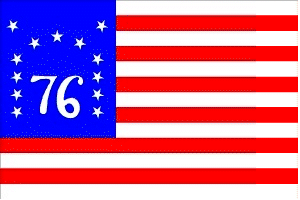 While many historians today believe that the distinctive Bennington Flag may have been made for the 50th Anniversary of the Declaration of Independence in 1826, there is strong evidence to indicate a flag similar to this was present on August 16, 1777 when General John Stark and his "Green Mountain Boys" defeated the 600 German mercenaries at Bennington, Vermont. This flag is sometimes referred to as the "Fillmore Flag". Nathan Fillmore took such a flag home from the battle of Bennington, where it was passed on through several generations of Fillmore's, including President Millard Fillmore. The Fillmore flag is now on display at the Bennington Museum in Vermont.
While many historians today believe that the distinctive Bennington Flag may have been made for the 50th Anniversary of the Declaration of Independence in 1826, there is strong evidence to indicate a flag similar to this was present on August 16, 1777 when General John Stark and his "Green Mountain Boys" defeated the 600 German mercenaries at Bennington, Vermont. This flag is sometimes referred to as the "Fillmore Flag". Nathan Fillmore took such a flag home from the battle of Bennington, where it was passed on through several generations of Fillmore's, including President Millard Fillmore. The Fillmore flag is now on display at the Bennington Museum in Vermont.
The "Stars and Stripes" in its various forms inspired a generation through a five year struggle for independence. Since 1776, no generation of Americans has been spared the responsibility of defending freedom...and more than one million Americans have died in defense of all our flag stands for. The "new constellation", envisioned by the Second Continental Congress in their resolution of June 14, 1777, found design in a new flag. Unlike celestial constellations, this new constellation was capable of growth, giving way to The Star Spangled Banner.
